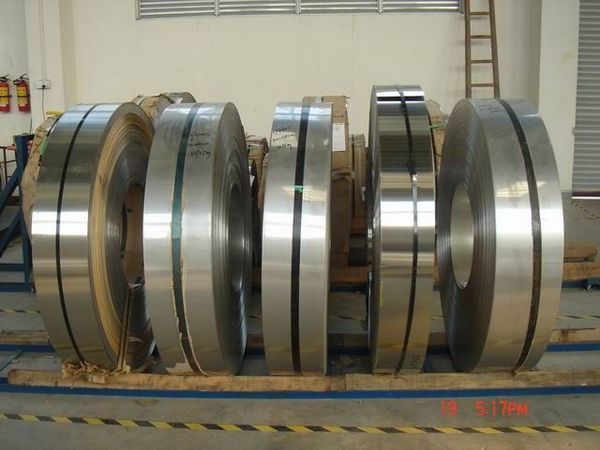Hardened spring sheets
Medium and high carbon steel sheet, which has a springy and elastic property, is capable of being loaded without permanent deformation after removal of load.
- Elastic change under these conditions, if the force is removed from the object, the body returns to its original state.
- Plastic change under these conditions, if the force is removed from the body, the body does not return to its original size.
Springs are objects that, by force and after removing it, return to their original shape and dimensions.
Because of the high forces and the changes in the shape of the spring used in the industry, it is necessary to increase the elasticity of the piece, that is, steel under high tensions can exhibit elastic deformation of itself. On the other hand, the springs are subjected to variable forces, and thus the steel required for these parts must be highly fatigued. Consequently, steels are used for the manufacture of springs, which have good amounts of silicon, manganese, chromium, vanadium and molybdenum.
(Grade: C55 (CK55)- C67 (CK67)- C75(CK75)- C85(CK85)- CRV(5OCRV4


- Hardness: Customer Tolerance: 32 HRC to 55 HRC Max
- Thickness: 0.1 mm min to 4 mm max
- Width: 10 mm min to 400 mm max
- Surface Finish: Bright, Blue polish, Brown & Grey polish
- Edge: Round Edge, Slit Edge, Square, Round (one side or both side)
- Coil Weight: As per customer demand
Features:

- سختی: حدود سختی بین 32 تا 55 راکول سی
- ضخامت: بین 0.1 میلیمتر تا 4 میلیمتر
- عرض: بین 10 میلیمتر تا 400 میلیمتر
- کیفیت سطح: براق، بنفش، خاکستری
- وزن کویل: بنا به سفارش مشتری
Usage and application
Types of accessories and parts of the building industry (spatula, lyceum, crusher, trowel, hand saw and sawing wood, and gantry saws and elevator door’s springs) – Automotive industry (springy flat washer, car roof knobs spring, disk parts and Clutch Parts, parts and Springs of Brake Pads, Belt Compressor Springs, Seat back Fillers) – Household Appliances (Types of Springs and Spring Parts, such as: Vacuum Cleaner Springs, Spring Spirals, Coiled Springs, etc.) – Road and rail transport (road signs, which are blocked by roads, to indicate routes that are springy and resilient when used in the event of vehicle collisions, returns to their original states.). All Industries (Lateton or Shemesh Sheets or Spring Bars, used in All Industries and Industry) – Ceramic, Cement, and Mine Industries (Ceramic Tile and Blast Cement Handle Blankets and Hardened Springy Anti- Abrasion Sheets in mineral machinery).
Spring
A spring is an elastic object that stores mechanical energy. When a conventional spring, without stiffness variability features, is compressed or stretched from its resting position, it exerts an opposing force approximately proportional to its change in length. The rate or spring constant of a spring is the change in the force it exerts, divided by the change in deflection of the spring.
The effect of elements on the properties of springs
Chromium – increasing tensile strength
Vanadium- Increasing tensile strength in high dimensions
Titanium – Resistance to corrosive materials and environments
Manganese – Increasing tensile strength in case of heat treatment (up to 1400 N / mm)
Silicon and manganese – Increasing tensile strength up to 1850 N / mm 2
History
Simple non-coiled springs were used throughout human history, e.g. the bow (and arrow). In the Bronze Age more sophisticated spring devices were used. Coiled springs appeared early in the 15th century in door locks. The first spring powered-clocks appeared in that century. In 1676 British physicist Robert Hooke postulated Hooke’s law.
Spring production
Springs are typically made of spring steel(Wide range of steels). Of course, some non-ferrous metals are also used in the manufacture of springs, such as titanium (for those with corrosion resistance) or beryllium copper (low electrical resistivity).
Types of springs: There are many types of springs available, most of which are believed to be a spiral spring. Below are some of the types of springs:
Spiral springs, they themselves are divided into two types:
- Torsion spring, the distance between them is very low, the load applied to a torsion spring is a torque or twisting force, and the end of the spring rotates through an angle as the load is applied.
- Compression spring – is designed to operate with a compression load, so the spring gets shorter as the load is applied to it.
- Tension/extension spring – the spring is designed to operate with a tension load, so the spring stretches as the load is applied to it.
- Serpentine spring – a zig-zag of thick wire – often used in modern upholstery/furniture.
- constant force springs: The shape of this type of springs is in the form of tubular straps that bring about a constant force.

